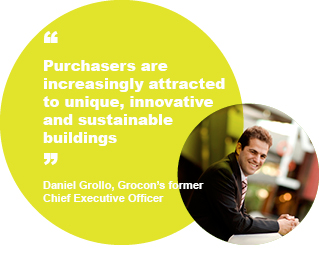Why sell or lease a green commercial building?

![]()
The benefits of green buildings
The business case for green buildings continues to stack up. When selling or leasing a green commercial building the benefits include:
> Higher return on investment
> Attract and retain tenants
> Environmental benefits
> Market recognition
Operating efficiencies
Green buildings are designed to be highly energy and water efficient, which makes them cheaper to operate.
- The Value of Green Star: A decade of environmental benefits (2013) finds that Green Star buildings use 66% less electricity and 51% water than the average Australian building. Because Green Star buildings deliver higher levels of energy and water efficiency, they are cheaper to operate.
- Modelling from CitySwitch has found that a typical financial or professional services firm operating from a 5 Star Green Star-rated office of 5,000 square metres would save $18,200 a year in electricity costs alone, not to mention massive savings in reduced absenteeism, employee retention and increased productivity.
- The World Green Building Council’s Business Case for Green Building (2013) finds that a minimal 2% upfront cost to support green design can result in average life cycle savings of 20% of total construction costs - more than 10 times the initial investment.
Since the first year of opening, annual electricity demand at the ANZ Centre has been reduced by over 12 per cent. This has translated into energy cost savings of around $200,000 per annum.
Kate Langan, ANZ Group General Manager for Property
| ANZ is reaping the rewards for its investment in the largest Green Star fitout in Australia.
Read more about the ANZ Centre in our case study. |
Higher return on investmentGreen buildings deliver consistently higher returns on investment compared their non-green counterparts.
|
|
|
Green proves gold in the case of Pixel Building in Melbourne. The $6 million transaction, though modest, netted $1 million more than would a similar sized, similar quality office without a Green Star rating.
Read more about the Pixel Building in our case study. |
|||
![]()
Attract and retain tenants
Greener buildings help attract prospective tenants and retain existing tenants.
- The GBCA’s Valuing Green (2008) report found that green buildings attract better quality tenants, such as government and ‘top tier’ corporates with stable businesses and strong commitments to corporate social responsibility.
- The World Green Building Council’s Business Case for Green Building (2013) found that buildings with a green rating, report an occupancy rate increase of up to 23%. The higher the rating, the higher the rental premium – with an average 3% increase in rent for each additional level of certification.
- Colliers International’s Office Tenant Survey (2012) found that 95 per cent of tenants want to be in a green building, up from 75 per cent two years earlier. ‘Green space’ was one of the top four attributes tenants were looking for – along with bike racks, childcare facilities and a gym.
- CBRE’s Do Green Buildings Make Dollars and Sense? (2009) found that that green buildings have 3.5% lower vacancy rates and 13% higher rental rates than the market.

|
For Australand, the driver for achieving a Green Star rating for The Key Spec 1 building in Melbourne was simple – the advantage it can provide in securing tenants. Read more about The Key Spec 1 in our case study. |

